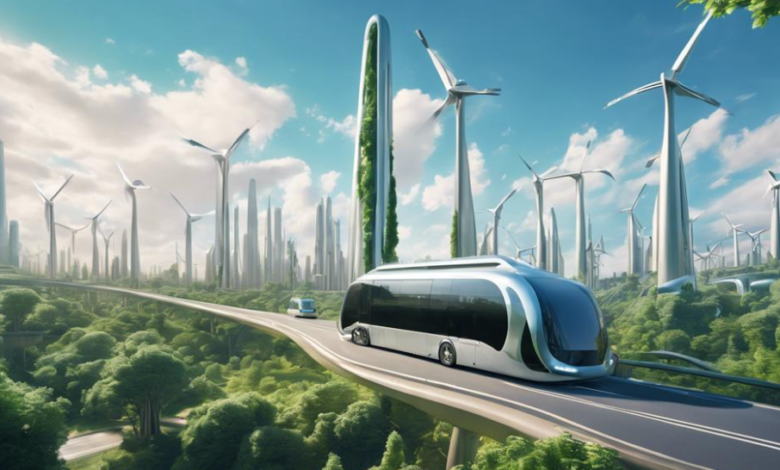The Most Innovative Sustainable Transportation Solutions in 2025

The way we move is changing faster than ever. In 2025, transportation is no longer just about getting from point A to B—it’s about efficiency, environmental responsibility, and smart urban living. Cities are embracing technologies and innovations that drastically reduce carbon emissions, minimize congestion, and make commuting seamless.
From electric and hydrogen-powered vehicles to autonomous systems and smart traffic management, some of the top sustainable transportation solutions in the US are redefining mobility for a greener future.
This article explores the most groundbreaking solutions transforming the transportation landscape today and answers the key questions about their impact, accessibility, and future potential.
Electric Vehicles: Pioneering the Green Revolution
In September 2025, global EV sales—including battery-electric and plug-in hybrid vehicles—reached a record 2.1 million units in a single month. This marked a 26% year-over-year increase, driven by strong demand in China, Europe, and the U.S. China remained the dominant market, contributing approximately two-thirds of the global total, with about 1.3 million units sold. North America and Europe also saw significant growth, with sales increasing by 66% and 36%, respectively. This surge underscores the accelerating adoption of EVs as a cornerstone of sustainable transportation solutions worldwide.
Electric vehicles (EVs) have rapidly emerged as a cornerstone of sustainable transportation solutions, offering a practical pathway to reduce carbon emissions and urban pollution. In 2025, innovations in battery technology, supportive government policies, and consumer awareness are converging to drive EV adoption at an unprecedented pace.
Extended Range and Faster Charging
One of the biggest hurdles for EV adoption—range anxiety—is being addressed with solid-state batteries that provide longer driving distances and faster charging times. This advancement not only makes EVs more convenient for daily commuters but also opens up possibilities for commercial fleets and long-distance travel, broadening their impact on reducing overall transportation emissions.
Diverse Vehicle Offerings
Automakers are no longer focusing solely on passenger cars. The EV market now spans compact city cars, SUVs, buses, and heavy-duty trucks. This diversification ensures that both individuals and businesses can transition to greener alternatives, making sustainable transportation solutions accessible across multiple sectors of the economy.
Expanding Charging Infrastructure
A robust charging network is critical to mainstream EV adoption. Globally, cities are investing heavily in public and private charging stations, including fast-charging hubs along highways and workplaces. This infrastructure not only increases convenience but also encourages a shift away from fossil-fuel-powered vehicles, accelerating the move toward cleaner urban mobility.
Environmental and Urban Impact
Beyond reducing greenhouse gas emissions, widespread EV adoption improves air quality, particularly in densely populated cities, and reduces noise pollution from traffic. When integrated with renewable energy sources, EVs become a powerful tool in achieving city-wide sustainability goals, demonstrating how technology and infrastructure together can transform mobility for the better.
The proliferation of EVs is leading to a significant reduction in greenhouse gas emissions, especially when powered by renewable energy sources. Additionally, EVs contribute to improved air quality and reduced noise pollution in urban areas.
See also: Logitech MX Master 4 Debuts as World’s First Haptic Feedback Mouse
Hydrogen-Powered Mobility: A Clean Alternative
The global hydrogen fuel cell vehicle market was valued at over USD 2.5 billion in 2025 and is projected to witness a compound annual growth rate (CAGR) of over 48.9%, reaching approximately USD 133.93 billion by 2035.
This growth is driven by advancements in hydrogen technology, increased environmental awareness, and supportive government policies promoting clean mobility solutions. Hydrogen fuel cell vehicles are emerging as a viable alternative for sectors where electrification is challenging, such as heavy-duty transport and public transit.
Hydrogen fuel cell technology is emerging as a powerful complement to electric vehicles in the push for sustainable transportation solutions. Especially for heavy-duty vehicles, buses, and long-distance transport where battery-electric options face limitations, hydrogen offers an efficient, zero-emission alternative.
Transforming Public Transportation
Several cities are leading the charge in hydrogen adoption. Bengaluru and Visakhapatnam, for example, are deploying hydrogen-powered buses as part of broader clean mobility initiatives. These buses not only reduce urban air pollution but also demonstrate how large-scale transit systems can transition to greener energy sources without compromising operational efficiency.
Building the Infrastructure
Widespread adoption of hydrogen mobility hinges on the development of refueling networks. Investments in hydrogen refueling stations—both urban and highway-based—are crucial to support public transportation fleets, logistics vehicles, and private users. Governments and private players are increasingly collaborating to establish this infrastructure, making hydrogen a more viable alternative for daily use.
Advantages Over Other Technologies
Hydrogen fuel cells generate only water vapor as a byproduct, making them a truly zero-emission solution. They also offer rapid refueling—typically under 10 minutes—and longer driving ranges compared to many battery-electric vehicles, which is particularly advantageous for buses, trucks, and commercial fleets. These attributes position hydrogen as a strategic solution for sectors where electrification alone cannot meet operational demands.
Environmental and Operational Impact
By integrating hydrogen-powered vehicles into public and commercial transportation systems, cities can significantly cut greenhouse gas emissions while maintaining high service efficiency. This combination of environmental and operational benefits highlights hydrogen’s growing role in creating sustainable, resilient, and scalable transportation networks in 2025.
Hydrogen fuel cells produce only water vapor as a byproduct, offering zero-emission transportation solutions. They also provide rapid refueling times and longer ranges compared to some battery-electric vehicles.
Autonomous Vehicles: Redefining Mobility
Autonomous vehicles (AVs) are transforming the future of transportation by combining cutting-edge technology with sustainable mobility goals. Beyond convenience, AVs have the potential to enhance road safety, reduce congestion, and optimize energy use, making them a key component of sustainable transportation solutions in 2025.
AI and Machine Learning: Smarter Navigation
AVs rely on advanced AI and machine learning algorithms to interpret data from sensors, cameras, and radar systems. This allows them to navigate complex urban and highway environments with precision, reduce human error, and maintain efficient traffic flow. Smarter navigation not only improves safety but also optimizes routes, reducing unnecessary fuel consumption and emissions.
V2X Communication: A Connected Ecosystem
Vehicle-to-everything (V2X) technology enables AVs to communicate with other vehicles, traffic signals, and urban infrastructure in real time. This connected ecosystem improves situational awareness, minimizes accidents, and allows for smoother traffic coordination. By reducing stop-and-go traffic and idling, V2X integration directly supports lower emissions and more efficient energy use.
Accessibility and Urban Impact
AVs have the potential to improve mobility for populations with limited access to personal vehicles, including the elderly and differently-abled individuals. Widespread adoption could reduce the total number of vehicles on roads, alleviating congestion and complementing other sustainable urban transport strategies.
Challenges and Considerations
Despite the promise, AV adoption faces hurdles such as regulatory approvals, public trust, cybersecurity risks, and high upfront costs. However, ongoing pilot programs and collaborations between governments and tech companies are paving the way for safer, smarter, and greener autonomous mobility.
Shared Mobility Platforms: Enhancing Urban Transportation
Shared mobility services—including ride-hailing, car-sharing, and bike-sharing—are redefining how cities approach transportation. By reducing dependence on privately owned vehicles, these platforms play a critical role in promoting sustainable transportation solutions, easing congestion, and improving accessibility in urban areas.
Integration with Public Transit: Seamless Multi-Modal Travel
Modern shared mobility platforms are increasingly integrating with public transportation networks, creating seamless multi-modal travel options. For example, commuters can combine a short bike ride with a metro trip or a ride-hailing service to cover first- and last-mile connections. This integration not only makes urban mobility more convenient but also encourages a shift away from private car usage, reducing overall traffic density and emissions.
Sustainability Initiatives: Green Fleets and Shared Rides
Many shared mobility companies are actively investing in electric vehicles (EVs) and incentivizing ride-pooling. Transitioning to EVs and promoting shared rides helps decrease urban air pollution, lowers greenhouse gas emissions, and reduces the carbon footprint of daily commuting. In addition, these initiatives support cities’ broader climate goals while demonstrating the scalability of some of the top sustainable transportation solutions.
Social and Urban Impact
Shared mobility improves access to transportation for underserved communities, offering affordable and flexible alternatives to private cars. By lowering the number of vehicles on the road, these services reduce congestion, decrease noise pollution, and optimize urban space usage. As cities grow, shared mobility platforms provide a scalable, technology-driven approach to building efficient and environmentally friendly transportation networks.
Shared mobility contributes to reduced traffic congestion, lower emissions, and increased access to transportation options, particularly in underserved areas.
Sustainable Urban Planning: Designing for the Future
Sustainable urban planning focuses on creating environments that promote sustainable transportation and reduce reliance on private vehicles.
- Mixed-Use Development: Designing neighborhoods that combine residential, commercial, and recreational spaces to reduce the need for long commutes.
- Active Transportation Infrastructure: Developing pedestrian and cycling pathways to encourage walking and biking.
- Public Transit Accessibility: Ensuring that public transportation is accessible, affordable, and efficient.
These strategies lead to reduced traffic congestion, lower emissions, and improved public health by promoting active lifestyles.
Smart Traffic Management: Using Technology for Efficiency
Smart traffic management systems use technology to optimize traffic flow, reduce congestion, and improve safety.
- Adaptive Traffic Signals: Signals that adjust in real-time based on traffic conditions.
- Integrated Data Systems: Collecting and analyzing data from various sources to inform traffic management decisions.
- Incident Detection and Response: Using sensors and cameras to detect accidents and dispatch emergency services promptly.
Smart traffic management systems lead to more efficient transportation networks, reduced travel times, and lower emissions.
Conclusion
In 2025, some top sustainable transportation solutions are at the forefront of efforts to combat climate change and create more livable cities. From electric and hydrogen-powered vehicles to autonomous systems and shared mobility platforms, these innovations are reshaping the way we move.
By integrating technology, policy, and design, we can build transportation systems that are efficient, equitable, and environmentally friendly.




